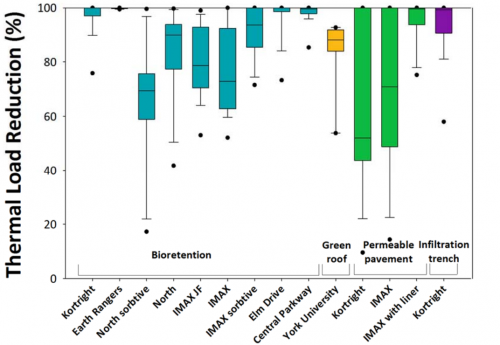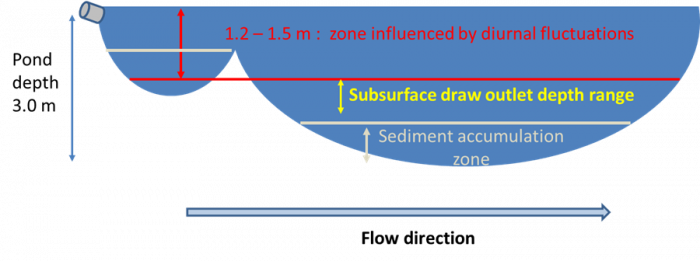Difference between revisions of "Stormwater Thermal Mitigation"
| Line 60: | Line 60: | ||
</br> | </br> | ||
[[File:Temp. depth pond.png|700px|thumb|left|The graph above depicts the temperature of a monitored stormwater pond within TRCA's watershed between Southern Ontario's two hottest months (July and August). Depths are in meters below the normal water level. Note strong diurnal fluctuations at the 0 m , 0.5 m and to a lesser extent at the 1.0 m depths.]]<br> | [[File:Temp. depth pond.png|700px|thumb|left|The graph above depicts the temperature of a monitored stormwater pond within TRCA's watershed between Southern Ontario's two hottest months (July and August). Depths are in meters below the normal water level. Note strong diurnal fluctuations at the 0 m , 0.5 m and to a lesser extent at the 1.0 m depths.]] | ||
[[File:Subsurface outlet depth.png|700px|thumb|right|The figure above highlights the optimal subsurface outlet depth above the sediment accumulation zone and below the zone most influenced solar radiation.]]<br> | |||
</br> | |||
<br> | |||
</br> | |||
<br> | |||
</br> | |||
===Expected Performance=== | |||
*Relative to a surface draw outlet, the expected 95th percentile temperature reduction provided by a 2 m deep draw outlet for years with similar air temperatures is between 3 and 5⁰C. | |||
*Water drained from outlets 2m below the surface will typically be less than 24°C at least 95% of the time. | |||
==In the Receiving Water== | ==In the Receiving Water== | ||
==References== | ==References== | ||
Revision as of 18:18, 13 April 2022
Overview[edit]
Streams draining urban areas are often much warmer than those draining natural ones due to changes in surface cover and hydrology. Urbanization increases stream temperatures by decreasing riparian shading and replacing natural landscapes with hard, dark-coloured pavements and roofs that absorb and store heat from the sun. The added impervious cover increases the volume of heated runoff while at the same time reducing discharge of cool groundwater to streams. This heating effect is further exacerbated as runoff flows through stormwater management ponds or other impoundments, where detained water is exposed to solar warming for extended time periods between rain events. This page explores different techniques for mitigating the effects of urbanization on the stream thermal regime.
Thermal Load[edit]
Since stream warming is influenced by the runoff temperature and volume of runoff draining to streams, impacts are best assessed through an evaluation of thermal loads both in the stream and in runoff discharged to streams. The thermal load is a function of the flow rate, water temperature, water density and heat capacity of water (or the energy required to increase a kg of water by 1 degree C).
Thermal Load = Q x ρ x T x C
Where:
- Q = flow rate (m3/s)
- ρ = water density (1000kg/m3)
- T = water temperature (°C)
- C = heat capacity of water (4187J/kg°C)
Since urban runoff volumes often increase by 2 to 5 times after development, and stormwater pond effluent temperatures are between 4 and 11°C warmer than pond influent temperatures in the summer, the overall thermal load increases to streams can be very significant (Van Seters et al. 2019).[1]
Temperature Target Selection[edit]
Setting a stream temperature threshold for the protection of aquatic life can be based on:
- Matching the water temperature regime of either a known pre-development thermal condition or the thermal condition of an undisturbed stream with similar characteristics; and,
- Meeting the upper tolerance of one or more target aquatic species.
Thermal Mitigation Techniques[edit]
Techniques for mitigating thermal impacts to streams can be implemented:
- Within the catchment near the source of runoff,
- Along the conveyance route to a treatment facility
- Within the stormwater pond or other stormwater treatment facility; and/or,
- Within the stream itself.
Upstream of the Pond[edit]
Any measure that decreases runoff volumes or temperatures or both can help mitigate thermal loads to streams or downstream treatment facilities. Examples include bioretention, infiltration trenches or chambers, enhanced swales, permeable pavements, absorbent landscaping and increased canopy cover. The temperature (event mean temperature) and thermal load benefits of the practices are shown in figures 1 to 3 below. The most effective practices were deeper systems such as trenches, some deep bioretention facilities, and practices that promote significant runoff volume reductions. Beyond reducing temperatures and runoff volumes, enhancing infiltration also helps re-establish the natural baseflow regime that existed prior to development.
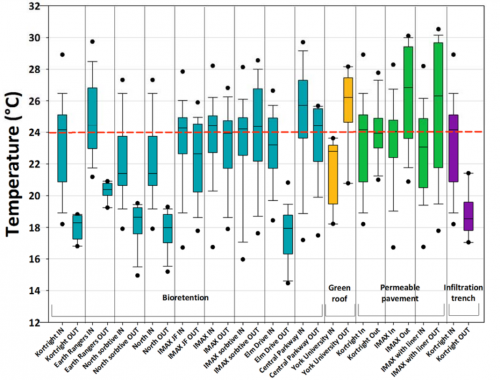

Within the Pond Block[edit]
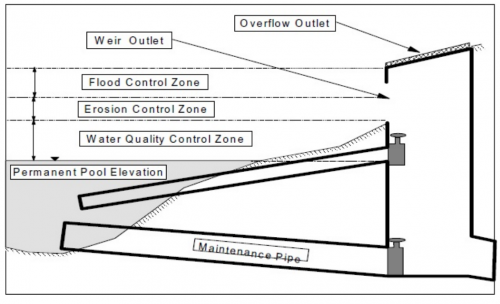
There are several opportunities to mitigate thermal impacts both within the pond itself and/or implemented within the upstream drainage area (and the lands surrounding) of the pond. Options shown in past studies to provide appreciable thermal mitigation benefits include (Van Seters and Dougherty, 2019)
Subsurface Draw Outlets[edit]
A reverse sloped outlet pipe drains cooler water from below the pond surface to a control manhole that is accessible from the bank for ease of maintenance. Deeper outlet result in cooler outflows than shallow outlets because pond water temperatures decrease with depth. The figure below shows an example of thermal stratification during the summer in a deep pond using said subsurface outlets.
Design Considerations[edit]
- Subsurface outlet inverts should be a minimum 1.2 m below the permanent pool water level to avoid influence from solar induced diurnal fluctuations.
- Subsurface outlets need to elevated from the pond bottom by between 1 and 1.5 m to allow space for sediment to accumulate. Reducing the separation distance may mean that the pond will need to be cleaned prior to its normal life cycle maintenance schedule, as per MECP guidance (link to our stormwater inspection and maintenance guide).
- Meeting outlet to bottom separation requirements by over excavating around the reverse slope outlet pipe will not provide the same temperature reduction benefits as a uniformly deep pond because the scour pool promotes vertical mixing of warmer top water with bottom water and there will be less cool bottom water below the outlet invert.
- Deeper ponds may require larger footprints to meet the MECP side slope requirements of 5:1 above the permanent pool and 3:1 elsewhere.
- Reverse sloped pipes should not be solid (not perforated) to ensure water is drawn from the deeper part of the pond.
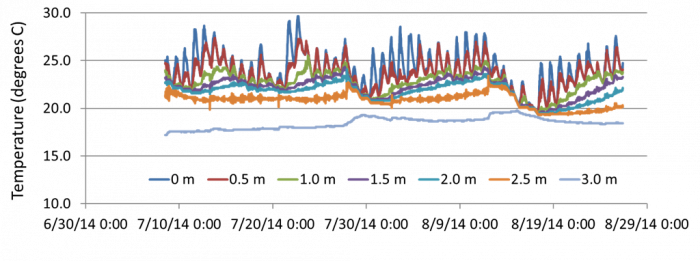
Expected Performance[edit]
- Relative to a surface draw outlet, the expected 95th percentile temperature reduction provided by a 2 m deep draw outlet for years with similar air temperatures is between 3 and 5⁰C.
- Water drained from outlets 2m below the surface will typically be less than 24°C at least 95% of the time.
In the Receiving Water[edit]
References[edit]
- ↑ Van Seters, T., Graham, C., Dougherty, J., Jacob-Okor, C., and David, Y. 2019. Data Synthesis and Design Considerations for Stormwater Thermal Mitigation Measures. Sustainable Technologies Evaluation Program. Ontario. https://sustainabletechnologies.ca/app/uploads/2019/04/Thermal-Synthesis-Final.pdf
- ↑ Van Seters, T., Graham, C., Dougherty, J., Jacob-Okor, C., and David, Y. 2019. Data Synthesis and Design Considerations for Stormwater Thermal Mitigation Measures. Sustainable Technologies Evaluation Program. Ontario. https://sustainabletechnologies.ca/app/uploads/2019/04/Thermal-Synthesis-Final.pdf
- ↑ Van Seters, T., Graham, C., Dougherty, J., Jacob-Okor, C., and David, Y. 2019. Data Synthesis and Design Considerations for Stormwater Thermal Mitigation Measures. Sustainable Technologies Evaluation Program. Ontario. https://sustainabletechnologies.ca/app/uploads/2019/04/Thermal-Synthesis-Final.pdf
- ↑ Van Seters, T., Graham, C., Dougherty, J., Jacob-Okor, C., and David, Y. 2019. Data Synthesis and Design Considerations for Stormwater Thermal Mitigation Measures. Sustainable Technologies Evaluation Program. Ontario. https://sustainabletechnologies.ca/app/uploads/2019/04/Thermal-Synthesis-Final.pdf
- ↑ Ministry of the Environment. 2003. Stormwater Management Planning and Design Manual. March, 2003. ISBN 0-7794-2969-9. PIBS 4329e. https://dr6j45jk9xcmk.cloudfront.net/documents/1757/195-stormwater-planning-and-design-en.pdf
